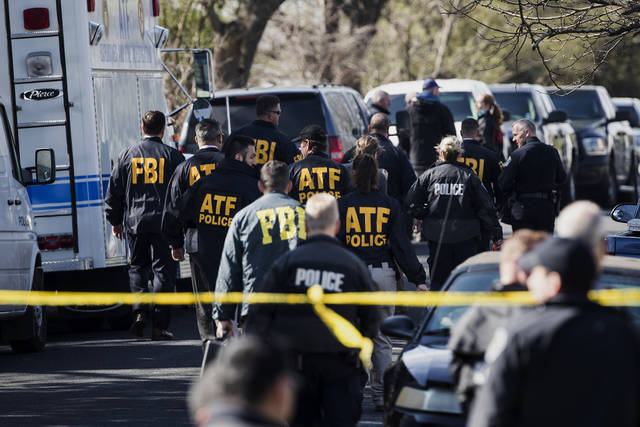AUSTIN, Texas — Three package bombs left on doorsteps in suburban neighborhoods have exploded in less than two weeks in Texas’ capital city, killing two people, wounding two others and leaving investigators vowing to look at any possible explanation for a motive.
Police said the bombings in eastern Austin — two Monday and one on March 2 — are likely linked. All the victims were minorities, and investigators are looking into whether race was a factor. However, they backed off initial suggestions that hate crimes could be a core cause.
The attacks unfolded as tens of thousands of visitors arrived for the busiest days of the South By Southwest music festival. The gathering didn’t appear related, but police urged tourists to be vigilant while warning residents to call authorities immediately if they receive unexpected parcel deliveries.
The first of Monday’s blasts occurred early in the morning when a package was carried into the kitchen and exploded upon being opened, killing a 17-year-old boy and wounding a 40-year-old woman, both of them black.
Hours later, authorities were called to the scene of another explosion also triggered by the opening of a package. That blast wounded a 75-year-old Hispanic woman, who was taken to a hospital with potentially life-threatening injuries.
Both of those explosions are thought to be linked to another early morning blast, this one on March 2, which killed a black man. Monday’s victims were not immediately identified but police said previously that the March 2 victim was 39-year-old Anthony Stephan House.
“This is the third in what we believe to be related incidents over the past 10 days,” Austin police Chief Brian Manley said during the second of two news conferences he held near each of Monday’s explosion sites.
At first Manley suggested that the blasts could constitute a hate crime, but later amended that to say authorities had not settled on a motive since the intended targets weren’t clear because multiple people live in the homes where explosives were placed. He also said they may possibly have been left at the wrong addresses.
“We are not ruling anything out at this point,” Manley said.
Investigators refused to provide many details about how the explosives were packaged, citing the ongoing investigation. But Manley described them as “not particularly large.” In all three cases, he said, the packages did not appear to have gone through the U.S. Postal Service or private carriers, but were left on doorsteps without knocking or ringing doorbells.
In a tweet, organizers of South By Southwest said they were “heartbroken by the explosions” and urged visitors to stay safe. Texas Gov. Greg Abbott offered a $15,000 reward for information leading to an arrest.
Manley told festival-goers, “There’s no reason to believe that you are at any greater risk.” But he added that they should “be aware” and “look for things that are suspicious.”
Four years ago, a driver plowed through a barricade and into a crowded street of South By Southwest revelers, killing four people and injuring many others. Extra security measures were taken, including additional policing, tougher security checks and brighter street lighting.
Keith Reynolds lives near the site of Monday’s second blast and said he heard what sounded like a propane explosion. He rushed outside and saw a cloud of hazy smoke and people running to help.
“There was a horrible screaming. You knew that something terrible was happening,” Reynolds said, adding that the victim’s body was riddled with holes as emergency responders took her out of the house.
There was nothing obvious linking the three areas where the bombs exploded, other than all were east of Interstate 35 that divides the city. The east side has historically been more heavily minority and less wealthy than Austin’s west side, although that has changed as gentrification has raised home prices and rents everywhere. It is also less true on the city’s northern outskirts, closer to where the first explosion occurred and where major firms like Dell, Apple and Samsung have sprawling complexes.
Monday’s first blast happened in Springdale Hills, a leafy neighborhood of houses mostly from the 1960s and 1970s. That was about 12 miles (20 kilometers) south of the home where the March 2 package bombing occurred. Monday’s second explosion, meanwhile, occurred about 5 miles (8 kilometers) south of the day’s first blast.
“It’s just a regular family neighborhood,” Reynolds said. “It’s just a grandmother, you know what I mean? Like, why?”
From his house at the end of the same street, 77-year-old retiree Gilbert Rendon heard the boom of Monday’s second blast and then saw a crush of scared people running his way — barefoot neighbors, some carrying babies with dogs chasing behind.
“They’re saying, ‘Somebody put a bomb! Somebody put a bomb!” Rendon said.
FBI teams are investigating along with the Bureau of Alcohol, Tobacco, Firearms and Explosives.
Manley said anyone receiving a package they don’t recognize should call 911. “Under no circumstances should you touch them, move them or handle them in any way,” he said.
———
Associated Press writer Jim Vertuno contributed to this report.


